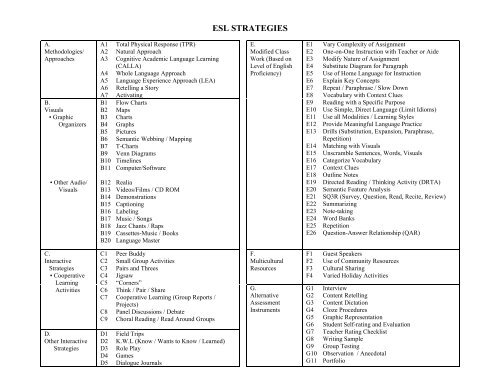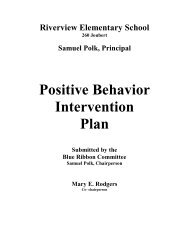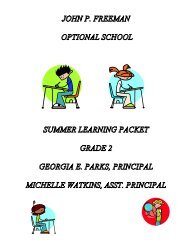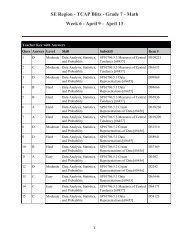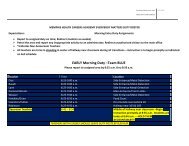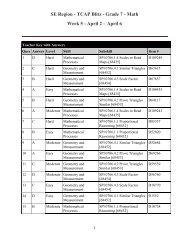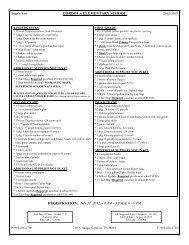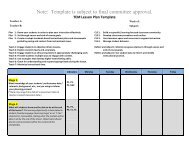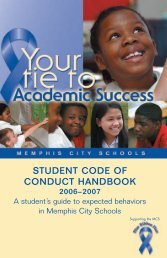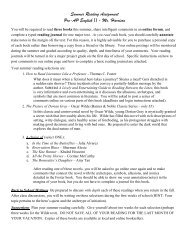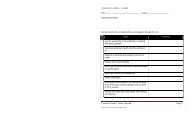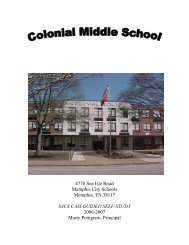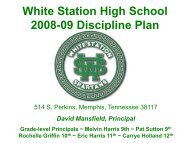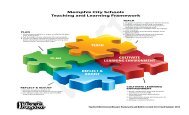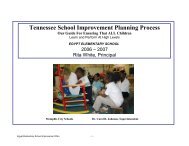ESL Strategies Chart w/ Methodologies
ESL Strategies Chart w/ Methodologies
ESL Strategies Chart w/ Methodologies
You also want an ePaper? Increase the reach of your titles
YUMPU automatically turns print PDFs into web optimized ePapers that Google loves.
A1. Total Physical Response (TPR)A. <strong>Methodologies</strong> / ApproachesIn TPR, teachers interact with students by delivering commands, and students demonstratecomprehension through physical response. Students are not expected to respond orally until theyfeel ready. This strategy involves little or no pressure to speak. (Asher, 1992).A2. The Natural ApproachIn this approach (Krashen and Terrell, 1983), students acquire new vocabulary throughexperiences and associations with the words, as such words are employed in a meaningfulcontext. Extended listening experiences include physical response activities, use of vividpictures to illustrate concepts, and active involvement of the students through physical contactwith the pictures and objects being discussed-by means of choice-making, yes-no questions, andgame situations.A3. The Cognitive Academic Language Learning ApproachThe Cognitive / Academic Language Learning Approach (CALLA) (Chamot & O’Malley, 1994)assists in the transition from a language arts program in which content is made comprehensiblethrough the use of ESOL strategies to the “mainstream” language arts curriculum by teachingstudents how to handle content area material with success. CALLA can help intermediate andadvanced students in understanding and retaining content area material while they are increasingtheir English language skills.A4. Whole Language ApproachIn a Whole Language Approach, linguistic, cognitive, and early literacy skills are developed inan integrated fashion. Instructional strategies for a Whole Language Approach include the fourlanguage skills of listening, speaking, reading, and writing (Goodman, Goodman & Hood, 1989).A5. Language Experience ApproachThe goal of the Language Experience Approach (LEA) is to have students produce language inresponse to first-hand, multi-sensorial experiences. The LEA uses the students’ ideas and theirlanguage to develop reading and writing skills.Steps for using the Language Experience Approach in the classroom (Dixon & Nessel,1983).Step 1: Providing the Experience / MotivationAn experience story is based on an experience the teacher and studentsshare.
A6. Retelling a StoryStep 2: Facilitation Language ProductionImmediately following an experience students need to interact with eachother to discuss the experience and what it meant to them.Step 3: Creating a Personal View RepresentationThe teacher has the students draw or paint a picture about somethinginteresting about the activity.Step 4: Retelling Events / ReactionsA volunteer is selected to share his or her picture with the group.Step 5: Writing Students’ StatementsThe teacher asks each student a question and records his / her answer,writing on the chalkboard exactly what the student says, using largemanuscript letters. After writing each statement, the teacher reads it backto the group for confirmation. When four or five statements are on theboard, the students decide their sequential ordering. The statements arethen numbered and transferred to a sentence strip, and the studentscorrectly arrange the strips on a chart holder.Step 6: ReadingAfter the chart or individual statements have been completed, studentsread their statements to each other and to the teacher.Step 7: WritingAs students develop writing skills, they copy the story into their notebooksor on lined paper.Step 8: Follow Up with ActivitiesThe story may be reread on several subsequent days either by the teacher,the students, or both. Students can also save the story with other languageexperience class stories to form their own class book for later reading.Storytelling is an important method for providing natural language experiences even during veryearly states of language acquisition. Stories should be highly predictable or familiar to thestudents from their native culture. They should be repetitive, making regular use of patterns.The story line should lend itself to dramatization and pantomime.
A7. Activating Prior KnowledgeFor material to be meaningful, it must be clearly related to existing knowledge that the learneralready posses (Omaggio, 1993). Teachers must plan activities in their instruction to provide therelevant context to activate students’ knowledge on the topic discussed.B. VisualsTeachers should use visual displays (i.e. graphs, charts, photos) in the lessons and assignments tosupport the oral or written message. Visual / graphic organizers should be used beforepresenting a reading passage. The provision of additional contextual information in the form of avisual should make the comprehension task easier (Omaggio, 1993).B1. Flow <strong>Chart</strong>sThis graphic organizer strategy assists students in representing position, role and orderrelationships among group elements. Students draw a representation of a sequential flow ofevents, actions, character roles, and / or decisions. Based on the situation, the graphic frame forthe flowchart can be student and / or teacher generated.B2-5. Maps / <strong>Chart</strong>s / Graphs / PicturesVisual aids that assist teachers in demonstrating relationships between words and concepts.B6. Semantic Webbing / MappingThis strategy provides LEP students with a visual picture of how words or phrases connect to aconcept or a topic. The instructor lists the target topic or concept, and builds a web-like structure(by circling and connecting the words) of words, phrases and verbs that students offer as beingconnected with the central topic. Class discussion may follow, with the instructor as thefacilitator, to argue against or to defend the perceived relationships of the called out words to thetopic, and eventually a consensus is reached as to what the class believes constitutes a “web” forthat concept.B7. T-<strong>Chart</strong>sT-<strong>Chart</strong>s are graphic organizers that compare / contrast two topics by dividing a page in half likea “T”.B8. Venn DiagramsVenn diagrams can be used to create a visual analysis of information that represents similaritiesand differences among concepts, peoples and things. This graphic organizer is constructed byusing two or more overlapping geometrical figures (i.e.: circles, squares, rectangles) that share an
Steps for using Captioning in the Classroom:1. Explain what a caption is.2. Have learners read information on handout you develop and distribute.3. Distribute illustrations and have students arrange in order of written information.4. Have each group caption the pictures, and read their captions to the class.B16. LabelingLabeling items in the classrooms will assist LEP students in the identification of items and inrelating them to written words.B17-19.Music / Songs, Jazz Chants / Raps, Cassettes-Music / BooksLanguage teachers frequently use music and chants in their classes. These activities aremotivating for students and assist in reinforcing and revisiting content area concepts whileacquiring English pronunciation and intonation patterns.Jazz Chants are rhythmic expressions of standard English as it occurs in situations through theuse of music or rap. Jazz chants improve intonation, vocabulary and grammar development.B20. Language MasterAuditory practice is obtained through the use of Language Master Cards to provide repetitivetasks that increase vocabulary and pronunciation skills.C. Interactive <strong>Strategies</strong>C1-3. Peer Buddy / Small Group Activities / Pairs and ThreesSmall cooperative groups are used to provide home language assistance and opportunities tonegotiate meaning in the development of second language communication skills in a nonthreateningenvironment.C4. JigsawThis is a cooperative learning strategy in which everyone becomes an “expert” about a topic orsub-topic, and shares his or her learning within a group setting so that eventually all memberslearn the content.To implement this strategy, the students are divided into groups; each group member is assigneda section or a part of the material selected for study. Each student meets with the members ofother similar groups who have similar assignments, forming a new group. This new group learnstogether, becomes an expert on their assigned material, and then plans how to teach this materialto members of their original groups.
Students later return to their original groups (whose members each now represent one of thedifferent areas of the topic being studies) and teach their area of expertise to the other groupmembers. In this matter, a topic or subject of great length can be covered and learned in afraction of the usual time. LEP students can learn the material must more effectively since theyalso must become teachers of the content they have learned to the members of their originalgroups. Jigsaw offers many opportunities for language acquisition, practice, enrichment andreinforcement.C5. “Corners”This is also a cooperative learning strategy, designed to optimize the learning of the assignedtask, and sharing that learning with other students. The teacher needs to assign small groups ofstudents to different corners of the classroom. They discuss various solutions, perspectives andpoints of view concerning a pre-selected issue, and decide on a presentation format. Finally,small groups present to the class.C6. Think / Pair / ShareThis strategy is well suited to help students develop their own ideas as well as build on ideas thatoriginated from co-learners. After reflecting on a topic, students form pairs and discuss, review,and revise their ideas, and eventually share them with the class.C7. Cooperative Learning (Group Reports / Projects)Cooperative Learning is a dynamic strategy through which students develop linguistic andacademic skills simultaneously (Calderon, 1988; Cohen, 1986; Green, 1991; Kagan, 1985). Inthis highly successful strategy, LEP students work together in small intellectually and culturallymissed groups to achieve a common goal. The outcome of their work is both a reflection on howwell the group functioned, and an academic assessment tool for the instructor.C8. Panel Discussions / DebateThis is also a cooperative learning strategy in which students organize planned presentations,where each member of the group takes one of the possible topic viewpoints. The individualpresentations may have oral, written or multimedia components. Students form teams toresearch, develop, and articulate their viewpoints. This strategy helps the students in developingthe ability to organize information, to filter ideas and to draw conclusions.C9. Choral Reading / Read Around Groups (RAG)This is an activity designed to give students an opportunity to think, discuss, and write abouttopics related to what they have read.
Procedure:1. After reading, teacher and students select a purpose and topic(s) for a short writingactivity. Students participate in a pre-writing activity such as brainstorming, developcriteria for the written work, then free-write for about ten minutes on a topic related to thereading.2. Students code their written work with numbers instead of using their own names.3. Papers are collected by the teacher, and students are divided into groups of four or fiveand given the same number of coded papers.4. Everyone in each group reads all the papers assigned to their group. This is done byreading for a short timed interval, and then passing the papers around the circle andrepeating the process until all papers are read.5. Each group votes on the one or two papers that meet the criteria best, and explains theirchoice.6. The teacher tallies the results of the papers voted “best” on the chalkboard and studentsshare their ideas about how and why these papers are most effective in achieving thegiven purpose, e.g., organization of information, use of descriptive terms, persuasiveness,effectiveness in making a point.D1. Field TripsD. Other Interactive <strong>Strategies</strong>This strategy consists of a planned learning experience in the community for the student group toobserve, study, and participate in a real-life setting, using the community as a laboratory. Theinstructor and the students plan and structure the experience by preparing beforehand foractivities during the visit and then engage in follow-up activities after the trip.D2. K-W-L (Knows / Wants to Know / Learned)An introductory or pre-activity strategy that provides a defined structure for recalling and stating;What the student knows regarding a concept or a topic; what the student wants to know, andfinally lists what has been learned and / or what is yet to be learned. To use this strategy, thestudent lists all the information he / she knows or thinks he / she knows under the heading “WhatWe Know”; then, the learner makes an inventory of “What We Want to Know”, categorizing theinformation about the topic the student expects to use.D3. Role PlayIn describing learning strategies, Dale (1990) emphasizes that direct and purposeful experiencesare best for all students, especially LEP learners. For example, students can demonstratecomprehension of a story by role-play through retelling, using realia, visuals, and propspreviously demonstrated by the instructor.
D4. GamesAllow LEP students to develop conversational skills in a non-threatening format. Games aremotivating for students and assist in reinforcing classroom material.D5. Dialogue JournalsA dialogue journal is a written conversation in which a student and the teacher communicateregularly and carry on a private conversation. Dialogue journals provide a communicativecontext for language and writing development since they are both functional and interactive(Peyton & Reed, 1990). Students write on topics of their choice and the teacher responds withadvice, comments, observations, thus, serving as a participant, not an evaluator, in a writtenconversation. Dialogue journals can and should be used very early in the language learningprocess. Students can begin by writing a few words and combining them with pictures.E1-18, 20, 22-25.E. Modified Class-work (Based on Level of English Proficiency)Modifying class-work involves the use of a variety of adaptations or modifications that provideclass-work appropriate to the language proficiency level of the LEP students, so thatcomprehensible instruction can occur. Modifying class-work allows for differences in studentlearning styles and cultural diversity factors.E-19. Directed Reading / Thinking Activity (DRTA)The teacher directs the students in activities to check their prior knowledge of the subject, set thepurpose for reading, and become acquainted with new vocabulary and concepts. At this stage,the students may also predict the content. Students then read small sections silently, whilekeeping their predictions and purposes for reading in mind. They read critically. After reading,the students think about what they read. They revise predictions or prove them. Follow-upactivities help students expand, summarize, and restate their ideas.E21. Survey, Question, Read, Recite, Review (SQ3R)This is a pre-reading activity that helps students focus on their topic, develop questions aboutthat topic, and answer those questions based on the reading.Procedure:1. S-Survey-“preview”2. Q-Question-Wh-words, such as: why, who, what, etc.3. 3R-Read, Recite, Review
E26. Question-Answer Relationship (QAR)Teachers can use QAR when developing comprehension questions, helping students to identifydifferent question types, and teaching text organization. The QAR classification is divided intofour question types in two categories:A. In the Book1. Right thereThe answer is in the text, usually easy to find. The words used to make up thequestion and words used to answer the question are Right There in the samesentence.2. Think and Search (Putting It Together)The answer is in the text, but you need to put together different text parts tofind it. Words for the question and words for the answer are not found in thesame sentence. They come from different parts of the text.B. In Your Head1. Author and YouThe answer is not in the text. You need to think about what you alreadyknow, what the author tells you in the text, and how it fits together.2. On Your OwnThe answer is not in the text. You can answer the question without evenreading the text. You need to use your own experience.F1-4 Multicultural ResourcesF. Multicultural ResourcesThese include community resources, local organizations and clubs (e.g. Hispanic Unity, Haitian-American, German-American, Italian-American Clubs, etc.)Organize cultural sharing through ESOL Parent Advisory Council, international fairs, parents ascultural representatives, business liaisons, multicultural guest speakers, ethnic folk musicpresentation, and multicultural students as resources for academic classes. For samples of variedholiday activities see Multicultural Calendar.G1. InterviewsG. Alternative Assessment InstrumentsInterviews are an excellent strategy to allow the student to master the competencies necessary togather information about a particular topic and report on it following predetermined format. This


